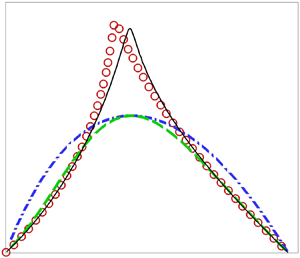Crossref Citations
This article has been cited by the following publications. This list is generated based on data provided by
Crossref.
Wu, Xiaoling
Chen, Qilong
He, Wenhai
Almadhor, Ahmad
and
Abbas, Mohamed
2023.
Unraveling thermoelastic performance of the multi-directional functionally graded composite structure by data-driven deep-learning approach.
Mechanics of Advanced Materials and Structures,
p.
1.
Ijaz Khan, M.
Shah, Faisal
Ali, Farhan
and
Alzahrani, Faris
2023.
First order chemical reaction response in mixed convective Falkner-Skan Sutterby fluid with Cattaneo-Christov heat and mass flux model.
Alexandria Engineering Journal,
Vol. 80,
Issue. ,
p.
559.
Li, Sheng
Chen, Ya-Zhou
Cheng, Ze
and
Peng, Jie
2023.
The role of soluble surfactant in the linear instability of a film coating inside a tube.
Journal of Fluid Mechanics,
Vol. 973,
Issue. ,
2023.
Numerical study of the natural transition of water boundary layers over heated/cooled flat plates.
Physics of Fluids,
Vol. 35,
Issue. 6,
2023.
On the origin of streamwise vortices in braid regions for compressible mixing layers.
Physics of Fluids,
Vol. 35,
Issue. 7,
Wang, Yuxuan
Xu, Jiakuan
Qiao, Lei
Zhang, Yang
and
Bai, Junqiang
2023.
Improved Amplification Factor Transport Transition Model for Transonic Boundary Layers.
AIAA Journal,
Vol. 61,
Issue. 9,
p.
3866.
Li, Li
Qiao, Lei
Xu, Jiakuan
and
Bai, Junqiang
2023.
Effects of Static Stability Margin on Aerodynamic Design Optimization of Truss-Braced Wing Aircraft.
Aerospace,
Vol. 10,
Issue. 7,
p.
603.
Qiao, Lei
Shen, Jian
Li, Yi
Huang, Jiangtao
Zhang, Jiao
Xu, Jiakuan
and
Bai, Junqiang
2023.
Improved hybrid model for transitional separated flows over a rough compressor blade.
Aerospace Science and Technology,
Vol. 140,
Issue. ,
p.
108434.
Han, Shaoyong
Ye, Qianqian
Almadhor, Ahmad
and
Abbas, Mohamed
2023.
Nonlinear size-dependent aerodynamics of axially reinforced doubly curved micropanel with GPLs: Application of innovative artificial neural network model.
Mechanics of Advanced Materials and Structures,
p.
1.
Vali, Hossein
and
Arefi, Mohammad
2023.
Extension of a novel higher order modeling to the vibration responses of sandwich graphene origami cylindrical panel.
Archives of Civil and Mechanical Engineering,
Vol. 23,
Issue. 4,
Fang, Ying
Wang, Yun
Qian, Renyin
Sharaf, Mohamed
and
El-Meligy, Mohammed A.
2023.
Time-efficient soft computational approach on vibration response of carbon-enriched drive shafts of super-fast race cars.
Materials Today Communications,
Vol. 36,
Issue. ,
p.
106887.
2023.
Weighted compact nonlinear hybrid scheme based on a family of mapping functions for aeroacoustics problem.
Physics of Fluids,
Vol. 35,
Issue. 4,
Wang, Zelin
Wang, Hui
Xiao, Heye
Bai, Junqiang
Zhao, Xiaodong
and
Wang, Shifeng
2023.
Enhancing heat dissipation and mass transfer of oxygen gas flow channel in a proton exchange membrane fuel cell using multiobjective topology optimization.
International Journal of Hydrogen Energy,
Vol. 48,
Issue. 83,
p.
32495.
Geng, Yajie
Zhang, Siqi
and
A. Alnowibet, Khalid
2023.
Application of the optimized deep networks in the prediction of the coupled thermoelasticity response of the axially graded composite system subjected to thermal shock loading.
Mechanics of Advanced Materials and Structures,
p.
1.
Liu, Yuanqiang
Liu, Yan
Ji, Zubi
Wang, Yutian
and
Xu, Jiakuan
2023.
Receptivity and Stability Theory Analysis of a Transonic Swept Wing Experiment.
Aerospace,
Vol. 10,
Issue. 10,
p.
903.
Lin, Qiu
and
Qi, Ruisheng
2023.
Optimal Weak Order and Approximation of the Invariant Measure with a Fully-Discrete Euler Scheme for Semilinear Stochastic Parabolic Equations with Additive Noise.
Mathematics,
Vol. 12,
Issue. 1,
p.
112.
Yin, Jinzhi
Zou, Yunhe
Li, Jianfeng
Zhang, Wei
Li, Xiyue
and
Habibi, Mostafa
2024.
Dynamic stability and frequency responses of the tilted curved nanopipes in a supersonic airflow via 2D hybrid nonlocal strain gradient theory.
Engineering Structures,
Vol. 301,
Issue. ,
p.
117240.
Waleed Ahmed Khan, M.
and
Khan, Imad
2024.
Tribological perceptions into shear thinning fluid flow: A quantitative analysis using rotating disk phenomenon.
Tribology International,
Vol. 192,
Issue. ,
p.
109308.
Elboughdiri, Noureddine
Sultan, Faisal
Ishaq, Muhammad Shoaib
Elmasry, Yasser
and
Iqbal, Amjad
2024.
Novel reduction schemes for a dissipative dynamical system: A study on slow invariant manifolds in chemical kinetics.
Ain Shams Engineering Journal,
Vol. 15,
Issue. 6,
p.
102751.
Li, Shuguang
Tarakaramu, Nainaru
Khan, Muhammad Ijaz
Sivakumar, Narsu
Satya Narayana, Panyam Venkata
Abdullaev, Sherzod
Tamam, Nissren
and
Eldin, Sayed M.
2024.
Enhanced heat transfer and fluid motion in 3D nanofluid with anisotropic slip and magnetic field.
Open Physics,
Vol. 22,
Issue. 1,






